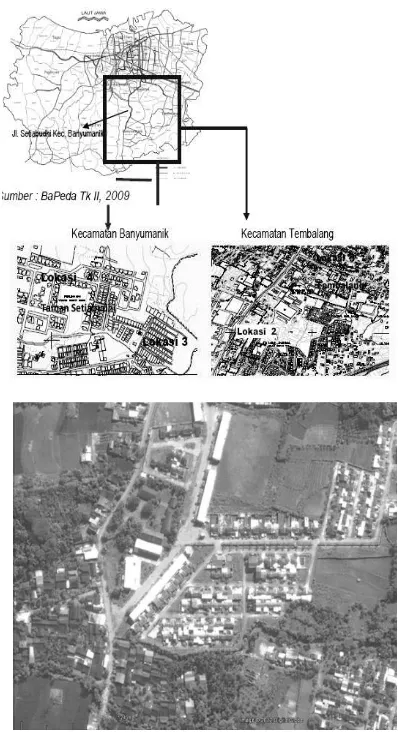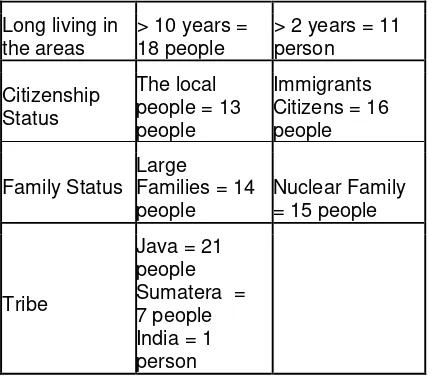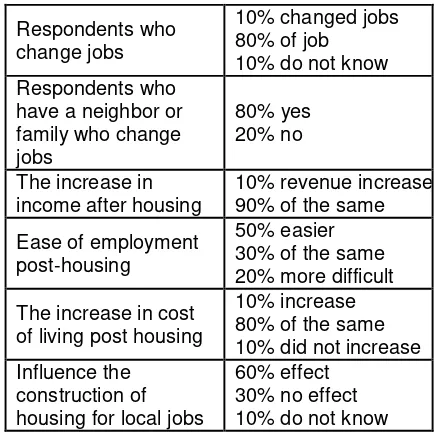The Development of Housing and It’s Socio
-Economic
Impacts to The Local Community
(Case Study : Semarang Sub Urban, Dictrict Tembalang)
Arief Rahman
Departement of Architecture, Faculty of Civil Engineering & Planning, Gunadarma University email: [email protected], [email protected]
Abstract
The development of suburban areas indicate that the area to be “exurban area”, that the development of the new urban population in large numbers came from the city and moved because it was attracted by the new residence or employment opportunities, but in socio-economic them still remain oriented to the city core. Another phenomenon of the development of the suburb that is the restructuring of the city’s core as result of the shift of functions from manufacturing center to the center of financial activities and services, while manufacturing activity increasingly shifts to the edge of the area, especially with the development of insdustrial areas and other. As for the purpose ofof this research is to know the socio-economic impacts of development of Semarang’s suburban housing, District Tembalang to the local community. A method of research used in this research is approach case study using by data qualitative and quantitative furnished with. The main data used is the quantitative data obtained from the questionnaire. A case study is a research that analys in one case and conducted in intensively, deep, specifics and comprehensive. This research is still with a limited number of respondendts and expected there is the research continued with more sample so the data more be valid. The socio-economic impacts of housing has already been seen in the public therefore particularly the government to immediately solve the problems of this mismatch so as not to be increased.
Keywords : regional development, housing development, socio-economic effects.
INTRODUCTION
Currently, the development of the largest fringe region can be seen from any of over the functions (conversion) land use area from agricultural areas to non agriculture happens in a massive manner. Without any arrangement of a fundamental, this over the
function with it’s variety of negative impact will
occur more broadly (Bell, 2001). The outskirts of Semarang, District Tembalang a sub urban area of Semarang that undergoing the construction of housing, occurring over the function agricultural land become a residential area fancy. It is certainly had an impact on socio-economic of the local community who previously worked in the agricultural sector. Society around the outskirts of Semarang, Tembalang,before the year 2009, the majority had worked as tenants of paddy fields.They get their wages in the form of money and rice from the owner of the land. In order to facilitate access to the paddy fields, many peasants who lived on the outskirts of
riverbanks area eventually grew into a small village.
In the period before 2009, a suburb of Semarang, District Tembalang is an under developed village, there is small road access less than adequate and this village is lacking socio-economic attractivenessas the sector available jobs only as a farm laborer. Then in 2009, occurring the development of a luxury residential that diverts function of rice field. Currently such housing is in the process of development and some of themare a few years inhabited. Now the out skirts of Semarang, District Tembalang has become start as the area that have many of the inhabitants, bustling traffic passed by vehicle. In a residential suburb, in addition to local residents who had long been settled, also
many immigrant that “pitted the fate” looking
some paddy fields that have not been affected service sector, such as the workshop, patched tire, doorsmeer, pedicab, or becomes such a small merchant stalls, stalls the pulse counters, small restaurant and the cracker.
In addition, the presence of the new society namely the lower classes who are geographically live together with local citizens, and communities that inhabit the upper class housing, bring its own influence to the change of social order of the local community. One example is in the process of mutual environmental hygiene, first citizens familiar with mutual. But then, upper-class residents rarely involved in housing activities of mutual. Local residents consider that housing residents is often reasoned when invited to mutual, inhabitant of housing prefer not involved with activities of local people but they still give compentationin the form of money to the local community. Thus, the local people also get advantage.
Community Empowerment Approach Uncorrectly selection of development strategy for the country and its people has produced a paradox and the tragedy of development as happened to the state of being evolved as follows:
1. The development did not produce progress, but rather increasing backwardness (the development of underdevelopment).
2. Produce dependence (dependency)
developing countries towards developed countries.
3. Produce dependence (dependency)
pheriphery against center
4. Produce dependence (dependency) public opposition to the government
5. Produce dependence (dependency) the small society (labour, small businesses, farmers, fishermen, etc.) against the owners of capital.
In principle, the conventional approach is characterized by transplantatif planning, top down, inductive, capital intensive, west-biased technological transfer, etc. Some of the paradigms of development is starting to shift from being conventional towards development of alternatives, namely:
1. Regional development 2. Environmental development 3. Community-based development 4. People-centered development 5. Sustainable development 6. Institution-based development
Striking characteristics that distinguish this alternative approaches is the emphasis of the locality, both in terms of institutional, community, environment, and culture. Policy implications of this approach is the emphasis on the transformative and transactive planning, bottom up, community empowerment, and participative, These things known by Community Development. Development strategy which is based on siding and empowermentunderstood as a process of transformation in social intercourse, economy, culture, and political community. Structural changes expected is the process that on going with naturally i.e. that produces shall enjoy. Vice versa, who enjoys shall that produces.The main approach in the concept of empowerment is that people do not become as objects of various development projects, but it is a subject of development efforts. Based on the concept so, then empowerment society must follow approach as follow; First, efforts should be focused. This is popularly called alignments. This effort is addressed directly to that requires, with programs designed to overcome the problem and according to their needs. Second, this program should be directly include or even implemented by the people who targeted. Includes the public who will be assisted by have some purpose, namely that the assistance was effective becauseit is in accordance with the will and ability to recognize and their needs. In addition, as well as increasethe ability of people with experience in designing, implementing, managing, and self improvement efforts and accountable economy. Third, use a group approach, because independently the poor people difficult to solve the problems it faces.Also the scope of aid become too large if the handling
done individually. This group’s approach most
effective and seen from the use of resources is also more efficient.
can include all facets of sociality, i.e. change in cerebration and interaction of their fellow citizens are increasingly become rational; changes in attitudes and orientation of economic life become more commercial; changes the work procedure of everyday that characterized by The division of labor in specialism activity increasingly sharp; changes in institutional and leadership of society become more democratic; the change in the procedures and tools of activities become more modern and efficient etc. Of several expert of social science opinion that quoted, can be synchronized their opinion about social transformation ,i.e. a process of changes, modifications or adaptations that occur in the life of society, including cultural values, behavioural patterns of community groups, socio-economic relations, as well as institutionals of society, both in the material aspects of life nonmateri.
Research Methods
The kind of research used in this research is a case study by using a quantitative approach and equipped with qualitative data.The main Data used is the quantitative data obtained from the questionnaire. Case study is a research which it’s research in one caseconducted in intensively deep, specifics, and comprehensive. A qualitative approach can be defined as an approach that generates data, writings, and behaviorfrom what obtained from what has been observed. Case study research is research that aims to delineate precisely the properties of an individualcircumstances, symptoms,and others which is the object research. The implementations is not confined to gathering data alone but also includes the analysis and interpretation of the data. Thus this study attempted to sort, analyze, classifying, comparing, and so on. So in the end the conclusion can be drawn deductively. Case study research is often aligned with the research and development is the preparation for further research. (Ginting, 2005: 14). The quantitative paradigm by using a detailed questionnaire collecting data in the form of numbers. Whereas, the qualitative paradigm by using case study research will collect data in the form of words, images instead of numbers. Thus the research will include tabulated numbers that are also equipped with a interview results data quoteto give an overview presentation of the report.
The Location of Research
Research location is in residential suburbs, of the city of Semarang, sub-district Tembalang. The researchers chose this location because of the Housing Development and changessocio-economic on the outskirts of Semarang residents, Tembalang Subdistrict, are in the process of transition, meaning that most citizens have really affected as to be out of work, but most others are in the verge of threat because inplanning a residential area will continue to be extended so that it can really spend the whole land of rice fieldmain the major livelihood of local people.
.
Figure 1: Location of Research, Tembalang District, Semarang
The Unit of Analysis and Respondent The Unit of Analysis
customarily used on most social research that is individuals, groups and social. There would be the unit of analysis and study of objects in this research are local citizens who lives what is called the 'unit of analysis'. There are two units of analysis that customarily used on most social research that is individuals, groups and social. There would be the unit of analysis and study of objects in this research. agricultural land tenants and residents suburbs, of the city of Semarang, sub-district detailed, in-depth interviews, and observation as part of the process of data analysis. Because hampered in seeing the head of the environment to get information about the local people, so that the only research data obtained from the questionnaire as many as 10 respondents and interview against 1 of the tenant sharecropper and 1 person of community leaders. The following description of questionnaire respondents in general:
Table 1. Characteristics of Respondents
Long living in Second, the tenant farmers of paddy fields (37 years old) he was a doer who knows a lot of information about the development of the agricultural work at the sites of research.
Citizens’s Knowledge bout The Housing Development
Sensitivity of the citizens against the housing development is still lacking, only 40% of respondents know aboutof the early residential development. 60% of respondents were less knowing when housing began in the wake. The citizens feel that the existing housing developments around the environment is not an important thingto care about. 40% of citizens know when housing was built, they can mention the years of development on a regular basis. This means that citizens have sufficient knowledge and concern for the development and the possibility of the implications for local people.
The Quality of Life and Social Relationships
Citizens already feel comfortable living in the location of research, 10% of respondents feel very comfortable, 70% of respondents feel comfortable, and only 20% who feel less comfortable staying on site of research. Residential development has no effect on the citizens ' convenience, , 40% feel more uncomfortable staying after construction of housing, while the other 60% say the same, meaning that housing development only just give a little harm citizens complained mainly the problem of environmental damage, i.e. damage to the road and air pollution due to the growing number of vehicles through the environment. Social relationships between local citizens more harmonious than between local citizens and residents of the housing. The following data tabulations:
Table 2. Citizens Social Relations Social relations between local
residents
40% harmonic 60% standard
Local mutual aid activities
50% exist 20% often 3% nothing Social relationships with the
inhabitants of the local housing
90% standard 10% worse Activities of mutual assistance
The difference in residence affects social relations of society, but there is another factor that is also affecting like religion and the tribe. People with the same religion, although different in stratification may be the case that good social relationships. Locals still conducting mutual cooperation, but residents of housing has never been involved in such activities. Residents of housing only pay a sum of money instead of mutual help.
The Influence of Residential Development to Education
Residents felt that residential development does not provide a significant impact on education of the local people. However, 40% of respondents said that people who continued their education post-built housing became more, 20% of respondents said there had been improvement of educational facilities.
Table 3. The influence of residential development to education Average education
population
High School and Graduate The number of people
who go to school after the construction of
The influence of housing for local education
10% effect 80% no effect 10% do not know
Effect of Housing Development for Livelihood Citizens
Housing development caused the change in the livelihood of society, 8 people of the respondents have a neighbor or family who changed job after the housing. As for the type of work that was involved was the night watchman, petty traders, housemaid and cleaning officers. As for the respondents themself is only 1 person who changed jobs, the majority of which 8 people stay on the job longer although affected housing development.
Income of residents also tend to be fixed and not affected by the establishment of housing, 9 of the respondents said there was no increase in income after housing built. The number of available jobs increases, 5 people
said to become easier to find a job and only 3 people who said no affect, 2 others said to become more difficult to find a job. The cost of living locals tend to be the same, unchanged despite the construction of housing, 8 people respondents said the cost of living just the same
Table 4. Effect of Housing Development for Livelihood Citizens
have a neighbor or family who change
The increase in cost of living post housing
10% increase 80% of the same 10% did not increase Influence the
construction of housing for local jobs
60% effect 30% no effect 10% do not know
CONCLUSION
From the data as described above, some conclusions can be drawn as follows:
1. Social relations between residents around residential areas remain harmonious, the emergence of a new class of residents housing raises jealousy, local citizens felt that residents of the housing estate is not part of existing community because they are not willing to follow the norm. Relationships between local citizens and residents of the housing for some people entwined still due to ethnicity or religion.
2. Housing development is not quite felt its that more people are continuing graduate education level post-housing development.
their profession to become workers in housing, residents also felt that looking for a roomy work became easier after the housing. As for the cost of living tends still the same without an increase.
BIBLIOGRAPHY
1. Basrowi. 2002, Metode Penelitian Kualitatif : Perspektif Mikro, Surabaya, Penerbit Insan Cendekia.
2. Bell, P.A. 2001. Environmental Psychology. Harcourt Brace College Publisher. Forth Worth
3. Black, J.A., and Champion, D. J. 1992.
Metoda dan Masalah Penelitian Sosial.
Jakarta. PT. Eresco.
4. Bounds, M.I. 2004. Urban Social Theory: City, Self, and Society. Oxford Press. 5. Ginting, Paham. 2005. Teknik Penelitian
Sosial. Medan: USU Press
6. Ihalauw, J. 2004. Bangunan Teori. Satya Wacana University Press
7. Komarudin. 1996. Menelusuri Pembangunan Perumahan dan Permukiman. Jakarta: Yayasan REI – PT. Rakasindo
8. Nawawi, Hadari. 1990. Metode Penelitian Bidang Sosial. Yogyakarta: UGM Press 9. Parsudi, S. 2000. Masyarakat Majemuk
dan Perawatannya, dalam Jurnal Antropologi Indonesia, No. 63 Tahun XXIV. hlm. 16-31.
10. Sarlito W. S. 1992. Psikologi Lingkungan,
Jakarta. PT. Gramedia Widiasarana Indonesia
11. Soetrisno, L. 1995. Menuju Masyarakat Partisipatif, Jakarta. Kanisius.
12. Syahrin, Alvi. 2003. Pengaturan Hukum dan Kebijakan Pembangunan Perumahan dan Permukiman Berkelanjutan. Medan: Pustaka Bangsa Press


